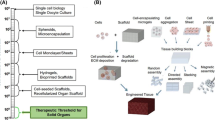Abstract
A native organ has heterogeneous structures, strength, and cell components. It is a big challenge to fabricate organ prototypes with controllable shapes, strength, and cells. Herein, a hybrid method is developed to fabricate organ prototypes with controlled cell deposition by integrating extrusion-based 3D printing, electrospinning, and 3D bioprinting. Multi-scale sheets were first fabricated by 3D printing and electrospinning; then, all the sheets were assembled into organ prototypes by sol–gel reaction during bioprinting. With this method, macroscale structures fabricated by 3D printing ensure the customized structures and provide mechanical support, nanoscale structures fabricated by electrospinning offer a favorable environment for cell growth, and different types of cells with controllable densities are deposited in accurate locations by bioprinting. The results show that L929 mouse fibroblasts encapsulated in the structures exhibited over 90% survival within 10 days and maintained a high proliferation rate. Furthermore, the cells grew in spherical shapes first and then migrated to the nanoscale fibers showing stretched morphology. Additionally, a branched vascular structure was successfully fabricated using the presented method. Compared with other methods, this strategy offers an easy way to simultaneously realize the shape control, nanofibrous structures, and cell accurate deposition, which will have potential applications in tissue engineering.










Similar content being viewed by others
References
Visser J, Melchels FPW, Jeon JE et al (2015) Reinforcement of hydrogels using three-dimensionally printed microfibres. Nat Commun 6:6933
Laronda MM, Rutz AL, Xiao S et al (2017) A bioprosthetic ovary created using 3D printed microporous scaffolds restores ovarian function in sterilized mice. Nat Commun 8:15261
Shao H, Ke X, Liu A et al (2017) Bone regeneration in 3D printing bioactive ceramic scaffolds with improved tissue/material interface pore architecture in thin-wall bone defect. Biofabrication 9(2):025003
Liu A, Sun M, Shao H et al (2016) The outstanding mechanical response and bone regeneration capacity of robocast dilute magnesium-doped wollastonite scaffolds in critical size bone defects. J Mater Chem B 4(22):3945–3958
Surmeneva MA, Surmenev RA, Chudinova EA et al (2017) Fabrication of multiple-layered gradient cellular metal scaffold via electron beam melting for segmental bone reconstruction. Mater Des 133:195–204
Zhu C, Pongkitwitoon S, Qiu J et al (2018) Design and fabrication of a hierarchically structured scaffold for tendon-to-bone repair. Adv Mater 30(16):1707306
Song J, Zhu G, Gao H et al (2018) Origami meets electrospinning: a new strategy for 3D nanofiber scaffolds. Bio-Design Manuf 1(4):254–264
Zhao P, Gu H, Mi H et al (2018) Fabrication of scaffolds in tissue engineering: a review. Front Mech Eng 13(1):107–119
Liu A, Xue G, Sun M et al (2016) 3D printing surgical implants at the clinic: a experimental study on anterior cruciate ligament reconstruction. Sci Rep 6:21704
Ho CMB, Mishra A, Lin PTP et al (2017) 3D printed polycaprolactone carbon nanotube composite scaffolds for cardiac tissue engineering. Macromol Biosci 17(4):1600250
Zein I, Hutmacher DW, Tan KC et al (2002) Fused deposition modeling of novel scaffold architectures for tissue engineering applications. Biomaterials 23(4):1169–1185
Wei C, Dong J (2014) Hybrid hierarchical fabrication of three-dimensional scaffolds. J Manuf Processes 16(2):257–263
Zhang B, Seong B, Nguyen VD et al (2016) 3D printing of high-resolution PLA-based structures by hybrid electrohydrodynamic and fused deposition modeling techniques. J Micromech Microeng 26(2):025015
Repanas A, Andriopoulou S, Glasmacher B (2016) The significance of electrospinning as a method to create fibrous scaffolds for biomedical engineering and drug delivery applications. J Drug Deliv Sci Technol 31:137–146
Jun I, Han HS, Edwards J et al (2018) Electrospun fibrous scaffolds for tissue engineering: viewpoints on architecture and fabrication. Int J Mol Sci 19(3):745
Soliman S, Sant S, Nichol JW et al (2011) Controlling the porosity of fibrous scaffolds by modulating the fiber diameter and packing density. J Biomed Mater Res Part A 96(3):566–574
Walser J, Stok KS, Caversaccio MD et al (2016) Direct electrospinning of 3D auricle-shaped scaffolds for tissue engineering applications. Biofabrication 8(2):025007
Gao Q, Gu H, Zhao P et al (2018) Fabrication of electrospun nanofibrous scaffolds with 3D controllable geometric shapes. Mater Des 157:159–169
Zhao P, Cao M, Gu H et al (2018) Research on the electrospun foaming process to fabricate three-dimensional tissue engineering scaffolds. J Appl Polym Sci 135(46):46898
Zhang B, Luo Y, Ma L et al (2018) 3D bioprinting: an emerging technology full of opportunities and challenges. Bio-Design Manuf 1:2–13
Ying G, Jiang N, Yu C et al (2018) Three-dimensional bioprinting of gelatin methacryloyl (GelMA). Bio-Design Manuf. https://doi.org/10.1007/2Fs42242-018-0028-8
Xie M, Gao Q, Zhao H et al (2018) Electro-assisted bioprinting of low-concentration GelMA microdroplets. Small 10:1804216
He Y, Yang FF, Zhao HM et al (2016) Research on the printability of hydrogels in 3D bioprinting. Sci Rep 6:29977
Ahn H, Ju YM, Takahashi H et al (2015) Engineered small diameter vascular grafts by combining cell sheet engineering and electrospinning technology. Acta Biomater 16:14–22
Gong W, Lei D, Li S et al (2016) Hybrid small-diameter vascular grafts: anti-expansion effect of electrospun poly ε-caprolactone on heparin-coated decellularized matrices. Biomaterials 76:359–370
Gao Q, He Y, Fu J et al (2015) Coaxial nozzle-assisted 3D bioprinting with built-in microchannels for nutrients delivery. Biomaterials 61:203–215
Gao Q, Liu Z, Lin Z et al (2017) 3D bioprinting of vessel-like structures with multilevel fluidic channels. ACS Biomater Sci Eng 3(3):399–408
Shao L, Gao Q, Zhao H et al (2018) Fiber-based mini tissue with morphology-controllable GelMA microfibers. Small 14(44):1802187
Acknowledgements
This work was sponsored by the National Nature Science Foundation of China (Nos. 51805474, 51622510, U1609207), the Science Fund for Creative Research Groups of National Natural Science Foundation of China (No. 51821093), and China Postdoctoral Science Foundation (No. 2017M621915).
Author information
Authors and Affiliations
Corresponding author
Ethics declarations
Conflict of interest
Q.G, P.Z, R.Z, P.W, J.F and Y.H declare that they have no conflict of interest.
Ethical approval
This paper does not contain any studies with human or animal subjects performed by any of the authors.
Rights and permissions
About this article
Cite this article
Gao, Q., Zhao, P., Zhou, R. et al. Rapid assembling organ prototypes with controllable cell-laden multi-scale sheets. Bio-des. Manuf. 2, 1–9 (2019). https://doi.org/10.1007/s42242-019-00032-z
Received:
Accepted:
Published:
Issue Date:
DOI: https://doi.org/10.1007/s42242-019-00032-z




